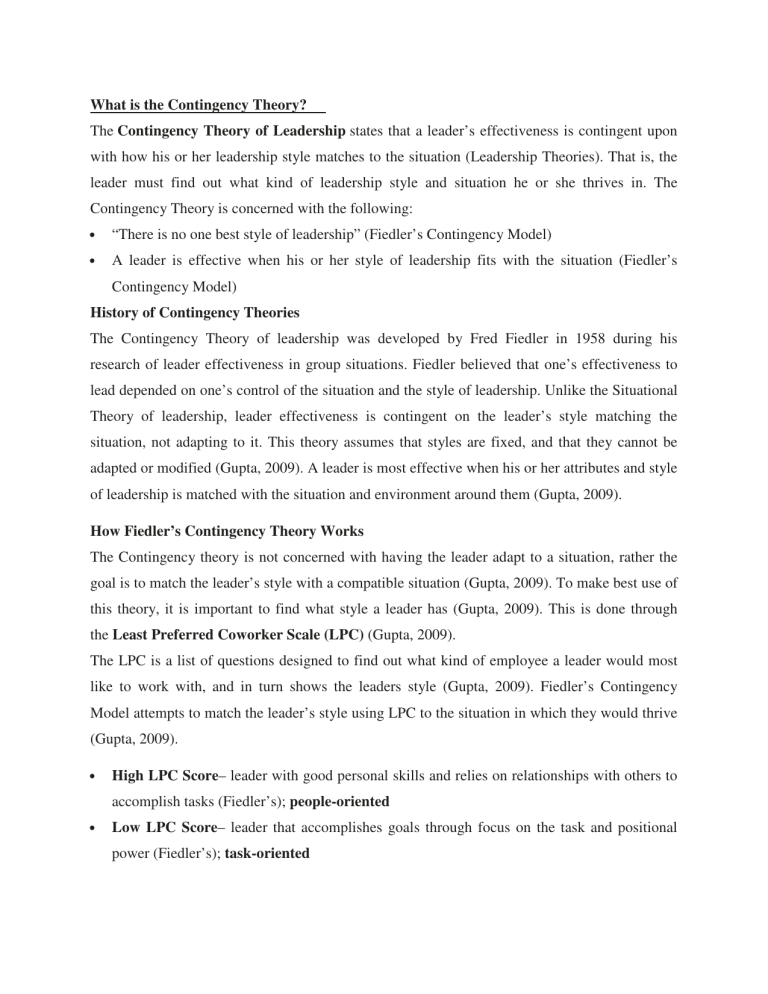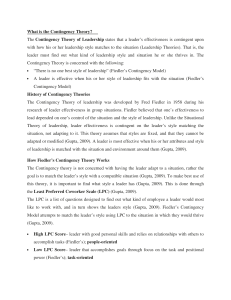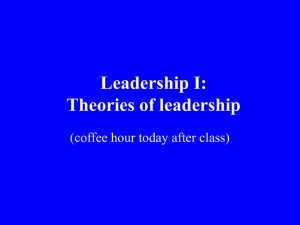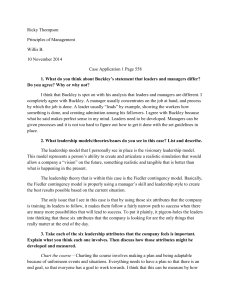
What is the Contingency Theory? The Contingency Theory of Leadership states that a leader’s effectiveness is contingent upon with how his or her leadership style matches to the situation (Leadership Theories). That is, the leader must find out what kind of leadership style and situation he or she thrives in. The Contingency Theory is concerned with the following: • “There is no one best style of leadership” (Fiedler’s Contingency Model) • A leader is effective when his or her style of leadership fits with the situation (Fiedler’s Contingency Model) History of Contingency Theories The Contingency Theory of leadership was developed by Fred Fiedler in 1958 during his research of leader effectiveness in group situations. Fiedler believed that one’s effectiveness to lead depended on one’s control of the situation and the style of leadership. Unlike the Situational Theory of leadership, leader effectiveness is contingent on the leader’s style matching the situation, not adapting to it. This theory assumes that styles are fixed, and that they cannot be adapted or modified (Gupta, 2009). A leader is most effective when his or her attributes and style of leadership is matched with the situation and environment around them (Gupta, 2009). How Fiedler’s Contingency Theory Works The Contingency theory is not concerned with having the leader adapt to a situation, rather the goal is to match the leader’s style with a compatible situation (Gupta, 2009). To make best use of this theory, it is important to find what style a leader has (Gupta, 2009). This is done through the Least Preferred Coworker Scale (LPC) (Gupta, 2009). The LPC is a list of questions designed to find out what kind of employee a leader would most like to work with, and in turn shows the leaders style (Gupta, 2009). Fiedler’s Contingency Model attempts to match the leader’s style using LPC to the situation in which they would thrive (Gupta, 2009). • High LPC Score– leader with good personal skills and relies on relationships with others to accomplish tasks (Fiedler’s); people-oriented • Low LPC Score– leader that accomplishes goals through focus on the task and positional power (Fiedler’s); task-oriented Task-oriented leaders are most effective when their positional power is high, as well as the task structure (Gupta, 2009). People or relation-oriented leaders perform their best when the relationship levels between themselves and followers are at their greatest (Gupta, 2009). After finding the style of the leader, Fiedler’s Model states that finding the best situation for the leader, also known as “situational favorableness” (Fiedler’s Contingency Model). A situation is defined by three factors in the contingency theory: 1. Leader-Member Relation- how the leader interacts with employees (Gupta, 2009). 2. Task Structure- how tasks are set up by the leader (Gupta, 2009). 3. Positional Power- the amount of power a leader has over followers (Gupta, 2009). These three factors combine to form the situation in which a leader’s style is effective or ineffective. If the three factors match up to the style of the leader, success is projected (Gupta, 2009). It is important to remember that the opposite can happen as well. If a leader is put into a situation opposite of his or her favored task structure, member relation, and level of power, then failure is to ensue (Gupta, 2009). The three factors of contingency situation have less of an impact on leaders who are task-oriented, or score low LPC’s, than leaders who are peopleoriented and score high LPC’s (Fiedler’s). By using the results from the LPC to find a person’s leadership style, and analyzing their preferred leader-member relation, task structure, and positional power, finding the right job or position for someone can be more accurately accomplished (Fiedler’s Contingency Model). What Is the Hersey-Blanchard Model? The Hersey-Blanchard Model suggests that there is no single leadership style that is better than another. Instead of focusing on workplace factors, the model suggests leaders adjust their styles to the followers and their abilities. Under the model, successful leadership is both task-relevant and relationship-relevant. It is an adaptive, flexible style, whereby leaders are encouraged to consider their followers—individuals or a team—then consider the factors that affect the work environment before choosing how they will lead. This ensures they will meet their goals. Because the Hersey-Blanchard model depends on a leader's decision-making skills, it uses an individualistic rather than a group approach. The Hersey-Blanchard Model is also referred to as the Situational Leadership Model or Theory. Understanding the Hersey-Blanchard Model The Hersey-Blanchard Model, or situational leadership, was developed by author Paul Hersey, and leadership expert Ken Blanchard, author of "The One Minute Manager." The model is not a static leadership style. Instead, it is flexible, wherein the manager adapts management style to various factors in the workplace including his or her relationship with other employees. That means managers who live by the model must choose the leadership style as it relates to the maturity of followers. For example, if follower maturity is high, the model suggests the leader provide minimal guidance. By contrast, if follower maturity is low, the manager may need to provide explicit directions and supervise work closely in order to ensure the group has clarity on their goals and how they are expected to achieve them. The maturity level of followers is divided into three categories: high, moderate, and low. High maturity includes highly capable and confident individuals who are experienced and work well on their own. Moderate maturity is generally divided into two groups—the first are employees who are capable, but lack enough confidence to take on the responsibility to do so, and the second has the confidence but is not willing to do the task at hand. Low maturity employees are not skilled enough to do the task but are very enthusiastic. Special Considerations Hersey-Blanchard Model and Leadership Styles Hersey and Blanchard came up with four different types of leadership styles based on the task and relationships that leaders experience in the workplace. According to the model, the following are styles of leadership managers can use: • Delegating style: A low-task, low-relationship style wherein the leader allows the group to take responsibility for task decisions. This is best used with high maturity followers. • Participating style: A low-task, high-relationship style that emphasizes shared ideas and decisions. Managers using the participating style tend to use it with moderate followers who are not only experienced but with those who aren't as confident to do the tasks assigned. • Selling style: Refers to a high-task, high-relationship style, in which the leader attempts to sell his ideas to the group by explaining task directions in a persuasive manner. This, too, is used with moderate followers. Unlike the previous style, these followers have the ability but are unwilling to do the job. • Telling style: Refers a high-task, low-relationship style wherein the leader gives explicit directions and supervises work closely. This style is geared toward low maturity followers. KEY TAKEAWAYS • The Hersey-Blanchard Model suggests no leadership style is better than another. • The model suggests managers adapt their leadership style to tasks and relationships in the workplace. • The model's leadership styles are related directly to the different maturity categories of followers or employees. Applying the Model and Its Limitations This leadership method lets executives, managers, and other positions of authority take charge of their followers based on the acumen, understanding, and context of the group. By taking into consideration how the strengths, weaknesses, and awareness of the followers can affect their performance and the outcomes of the project, leaders can apply an appropriate structure and degree of control to achieve the desired result. There are limitations to the model that may be beyond the leader’s control. The position and authority of the leader may be restricted by the operational chain-of-command or hierarchy for an organization, which could force them to adopt rigid styles rather than adapt to follower maturity. Furthermore, time constraints, a narrow field of options, and limits on available assets can also force managers to act based on the circumstances they face, eliminating the possibility of enacting strategies built around follower maturity. Advantages and Disadvantages of the Hersey-Blanchard Model Although this leadership model may be sound, in theory, it may not necessarily be applicable in every situation. So, it comes with advantages and disadvantages. Some of the advantages of using an adaptive leadership style are that leaders can change their style at their own discretion at any time. Secondly, employees may find a leader who adapts to shifting changes in the workforce as a desirable trait. It is also a simple and easy-to-apply leadership style, meaning a manager can quickly evaluate a situation and make decisions as he or she sees fit. On the downside, situational leadership may put too much responsibility on the manager, whose decisions may be flawed. The model may not also be applicable to different cultures. The model may also prioritize relationships and tasks, as opposed to a company's long-term goals.





